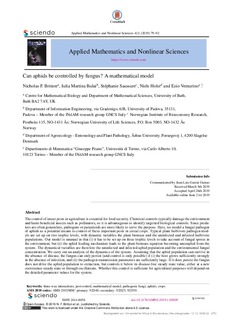| dc.contributor.author | Britton, Nicholas F. | |
| dc.contributor.author | Bulai, Iulia Martina | |
| dc.contributor.author | Saussure, Stephanie | |
| dc.contributor.author | Holst, Niels | |
| dc.contributor.author | Venturino, Ezio | |
| dc.date.accessioned | 2020-01-03T10:02:44Z | |
| dc.date.available | 2020-01-03T10:02:44Z | |
| dc.date.created | 2019-08-12T19:24:39Z | |
| dc.date.issued | 2019-06-21 | |
| dc.identifier.citation | Applied Mathematics and Nonlinear Sciences (AMNS). 2019, 4 (1), 79-92. | nb_NO |
| dc.identifier.issn | 2444-8656 | |
| dc.identifier.uri | http://hdl.handle.net/11250/2634735 | |
| dc.description.abstract | The control of insect pests in agriculture is essential for food security. Chemical controls typically damage the environment and harm beneficial insects such as pollinators, so it is advantageous to identify targetted biological controls. Since predators are often generalists, pathogens or parasitoids are more likely to serve the purpose. Here, we model a fungal pathogen of aphids as a potential means to control of these important pests in cereal crops. Typical plant herbivore pathogen models are set up on two trophic levels, with dynamic variables the plant biomass and the uninfected and infected herbivore populations. Our model is unusual in that (i) it has to be set up on three trophic levels to take account of fungal spores in the environment, but (ii) the aphid feeding mechanism leads to the plant biomass equation becoming uncoupled from the system. The dynamical variables are therefore the uninfected and infected aphid population and the environmental fungal concentration. We carry out an analysis of the dynamics of the system. Assuming that the aphid population can survive in the absence of disease, the fungus can only persist (and control is only possible) if (i) the host grows sufficiently strongly in the absence of infection, and (ii) the pathogen transmission parameters are sufficiently large. If it does persist the fungus does not drive the aphid population to extinction, but controls it below its disease-free steady state value, either at a new coexistence steady state or through oscillations. Whether this control is sufficient for agricultural purposes will depend on the detailed parameter values for the system. | nb_NO |
| dc.language.iso | eng | nb_NO |
| dc.rights | Navngivelse 4.0 Internasjonal | * |
| dc.rights.uri | http://creativecommons.org/licenses/by/4.0/deed.no | * |
| dc.subject | Three-way interactions | nb_NO |
| dc.subject | Pest control | nb_NO |
| dc.subject | Mathematical model | nb_NO |
| dc.subject | Pathogenic fungi | nb_NO |
| dc.subject | Aphids | nb_NO |
| dc.subject | Crops | nb_NO |
| dc.title | Can aphids be controlled by fungus? A mathematical model | nb_NO |
| dc.type | Journal article | nb_NO |
| dc.type | Peer reviewed | nb_NO |
| dc.description.version | publishedVersion | nb_NO |
| dc.rights.holder | © 2019 N. F. Britton et al., published by Sciendo. | nb_NO |
| dc.subject.nsi | VDP::Landbruks- og Fiskerifag: 900 | nb_NO |
| dc.source.pagenumber | 79-92 | nb_NO |
| dc.source.volume | 4 | nb_NO |
| dc.source.journal | Applied Mathematics and Nonlinear Sciences (AMNS) | nb_NO |
| dc.source.issue | 1 | nb_NO |
| dc.identifier.doi | 10.2478/AMNS.2019.1.00009 | |
| dc.identifier.cristin | 1715396 | |
| dc.relation.project | Norges forskningsråd: 244526 | nb_NO |
| dc.relation.project | COST (European Cooperation in Science and Technology): FA1045 | nb_NO |
| cristin.unitcode | 7677,3,0,0 | |
| cristin.unitname | Divisjon for bioteknologi og plantehelse | |
| cristin.ispublished | true | |
| cristin.fulltext | original | |
| cristin.qualitycode | 1 | |

